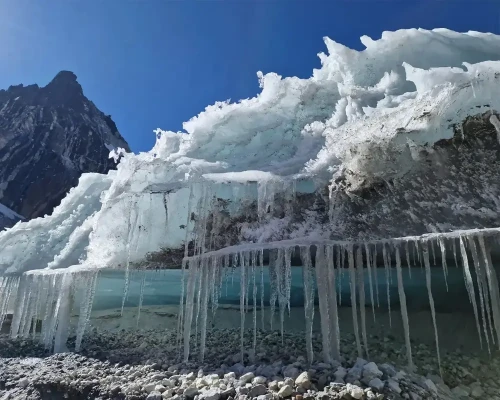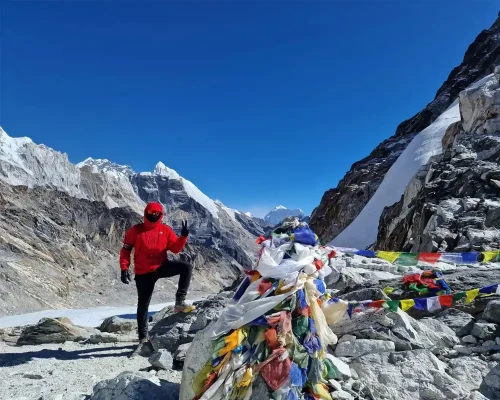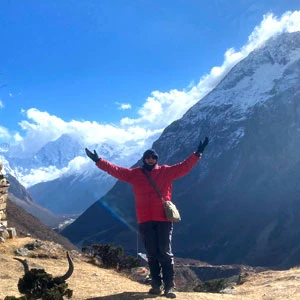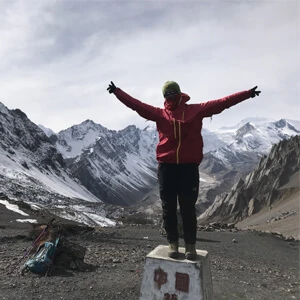Everest Base Camp Trek with Lobuche Peak Climbing
Do you fancy one of life's ultimate challenges? Are you fit and willing to push yourself just that little bit further? Then why not come, join us, and commit yourself to this spectacular peak in the mighty Himalayas?
Situated at the foot of the Khumbu Glacier on the Classic Everest Trail, Lobuche Peak Climbing is a stunning example of what the Himalayas are all about. It sits a stone's throw away from the highest rung on the stairway to the heavens, and as you would expect, like any caring big brother, mighty Mount Everest is with us on our climb. You do not need to be an experienced mountaineer, as you will receive training from our mountain Sherpas. However, you do need to be fitted with enough stamina to reach the goal. Some previous experience in the use of crampons would be a bonus, and in addition, some knowledge of the use of ropes and fixed lines would also be useful. While designated as a trekking peak, Lobuche is a testing climb that needs to be treated with respect.
Lobuche Peak, at an elevation of 6,119 meters (20,075 feet) above sea level, is frequently used by mountaineers as acclimatization and practice before attempting to summit Everest. Although it is technically more difficult and more strenuous than Island Peak, the reward is a very special one, providing 360-degree out-of-this-world vistas within a sea of white peaks stretching as far as the eye can see.
We begin this epic journey to Everest Base Camp with Lobuche Peak Climbing in the colorful, riotous capital of Kathmandu, where we have two days to adjust, explore, and soak up the culture. A briefing is held to go through the itinerary in more detail and make any necessary last-minute preparations for the challenge ahead. The fun begins after boarding our small plane for the 35-minute flight along the spine of the Himalayas to land at the Sir Edmund Hillary airstrip at Lukla, carved into the hillside. From here, we embark on our journey as we move up the Khumbu Valley to reach our goal. The days are carefully crafted to allow our bodies to fully acclimatize along the way, with rest days slotted in.
The Khumbu is a very special place, enriched by the unique culture of its inhabitants, the legendary Sherpas. For devout Buddhists, the trail to Everest Base Camp(EBC) is laced with monasteries, chortens, and colorful prayer flags. Trek alongside yaks, monks, and mountain expeditions heading for Everest and other great peaks. We are more than prepared for what is to come by the time we arrive at the base of Lobuche Peak Climbing, a Himalayan summit experience that often shapes lives for many years to come.
Buzzing and often floating as we make our way back down the trail to Lukla and eventually back to Kathmandu for a celebratory party.
Furthermore, you may choose our other exclusive climbing packages, like Island Peak Climbing, Mera Peak Climbing, or the Everest Three High Passes Trek with Island Peak Climbing.
EBC Trek with Lobuche Peak Summit Difficulty
The first part of the journey is the Everest Base Camp Trek, which involves long days of hiking at high altitudes that reach up to 5,364 meters at Everest Base Camp.
Lobuche Peak is graded at the ‘2B’ level in the Alpine Grading System. It is among the practice peaks recommended for beginners, but mountain climbing requires some technical skills, such as using an ice axe and crampons, rope management, and hiking on glaciers. The route involves steep ice and snow, crevassed glacier moraines, and rocky terrain.
Combining the Everest Base Camp Trek with the Lobuche Peak Climbing involves trekking at high elevations, gradually gaining altitude before culminating in the 6119 metres of Lobuche Peak. This kind of significant peak climbing and trekking can cause altitude sickness if proper acclimatization is not followed.
Although the EBC Trek with Lobuche Peak Summit is not technical compared to other challenging mountains in Nepal, the high altitude and long days make it very exhausting. The summit day is particularly arduous and requires 8-9 hours of steep climbing on snow and ice.
Moreover, the success rate is around 8 out of 10 climbers, so with proper fitness, professional guidance, and good gear, you can navigate the summit more easily.
Best Season for Lobuche Peak and Everest Base Camp Trekking
Nepal experiences four distinct seasons, each with its charm. However, Spring and Autumn are widely considered the best times to embark on the Everest Base Camp trek with Lobuche Peak Climbing.
Spring Season
After the chill of winter subsides, the Everest region welcomes spring, marked by mild temperatures and clear skies that offer breathtaking views of the mountain ranges. Spring is renowned for its excellent visibility of the peaks and stable trail conditions, making it an ideal time for trekking and climbing. Daytime temperatures range from 5 to 20 degrees Celsius. This season is also notable for the blooming period, which fills the region with the fragrance of flowers in full bloom.
Autumn Season
Autumn is equally revered as one of the best times of the year for trekking and peak climbing in the Everest region. The season is enriched by festivals such as Dashain, Tihar, Mani Rimdu, and Lhosar, providing a unique opportunity to immerse in the local culture and lifestyle. The weather during autumn will be stable, featuring clear skies and mild temperatures, particularly favourable in October and early November. Daytime temperatures range from 1 to 15 degrees Celsius, with crisp and clear air that enhances the visibility of the majestic Himalayan peaks.
Permit Cost
To climb Lobuche East Peak, trekkers need different kinds of trekking and climbing permits which are given below:
Everest Base Camp Trek Permit Cost Breakdown:
- Sagarmatha National Park Entry Permit: NPR 3000 per person.
- Khumbu Pasang Lhamu Rural Municipality Permit: NPR 3000 per person.
Lobuche Peak Climbing Permit Cost Breakdown:
- Spring (March–May): USD 250 per person.
- Autumn (September–November): USD 125 per person.
- Winter (December–February): USD 70 per person.
- Summer (June–August): USD 70 per person.
How can I book the Lobuche Peak Expedition?
To book your trek with us, you have to send a deposit of 10% of the total cost of the trek. Please also forward a copy of your passport, and flight details if and when available. For your convenience, you may forward the deposit to us online through our website. It is completely safe, and as soon as you make it, you will get an automatic receipt in your inbox. The rest of the payment can be paid upon arrival.
For more details, do not hesitate to contact our experts now.






 based on 1 review
based on 1 review





